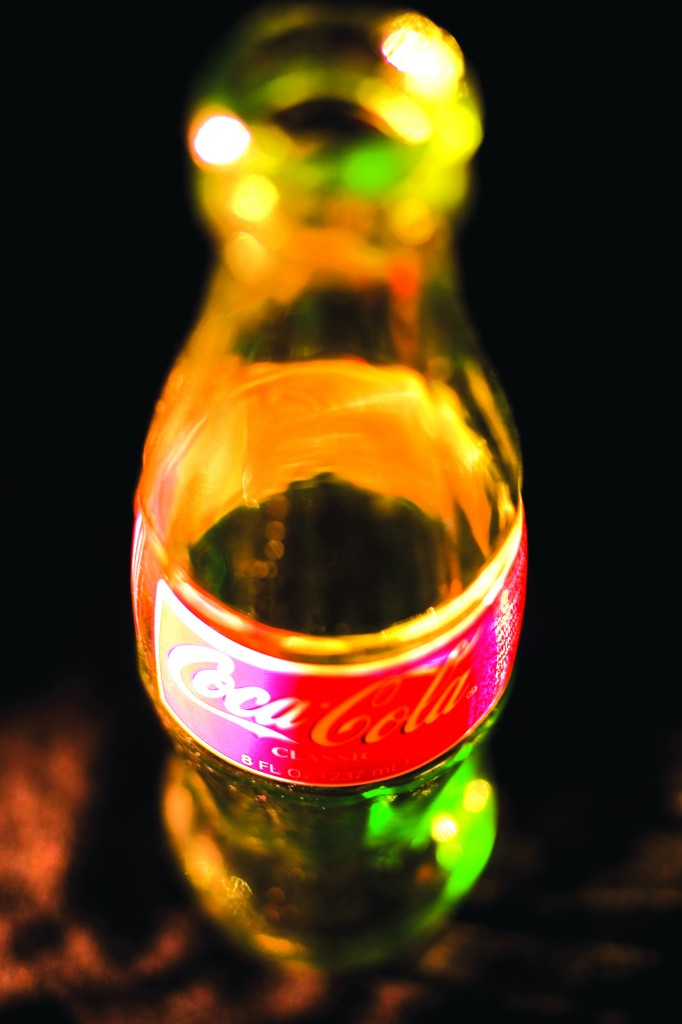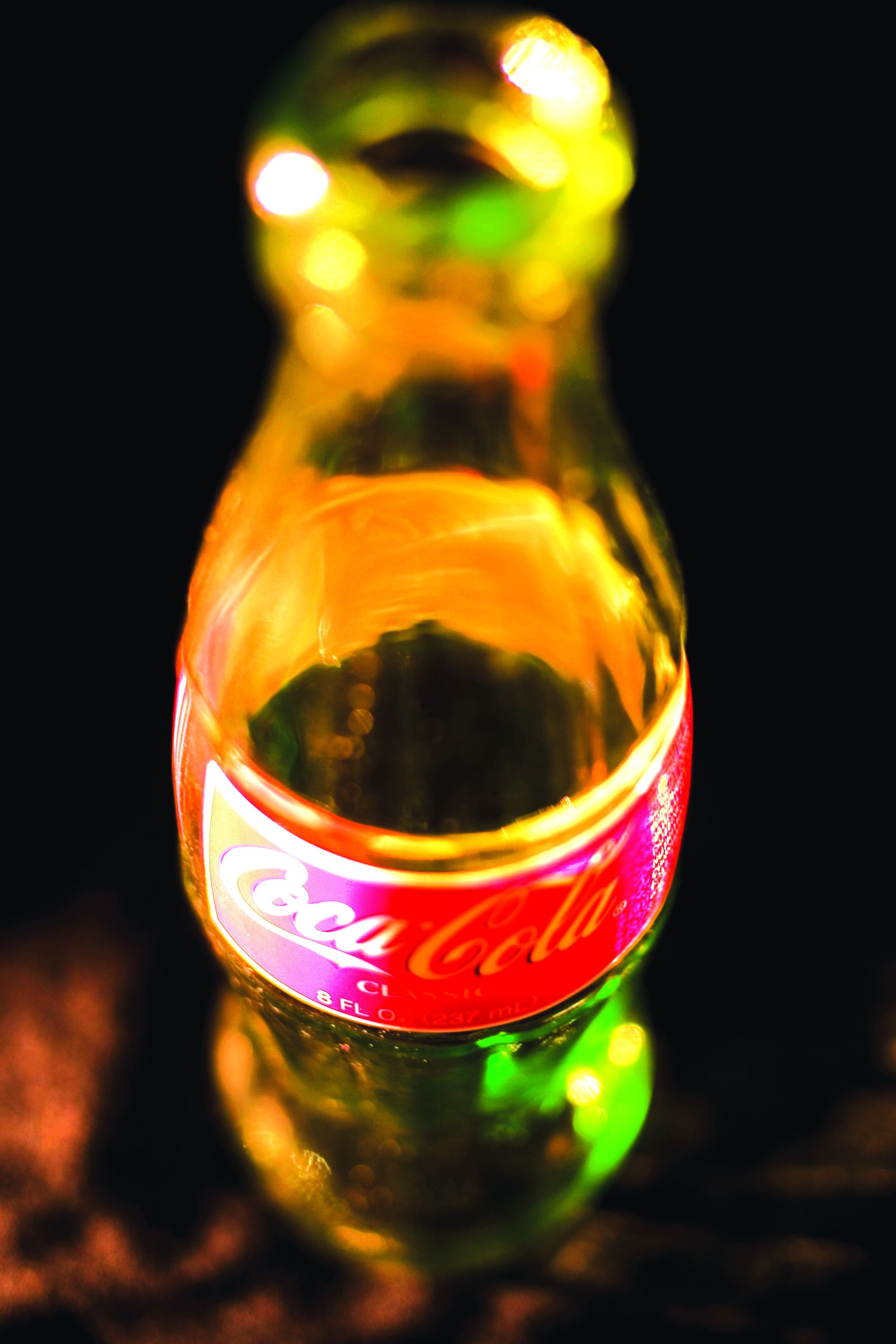By Katie Stobbart (The Cascade) – Email
Print Edition: September 17, 2014

The Abbotsford campus green is usually a quiet, pastoral atmosphere. Students can often be found studying or enjoying the afternoon sunshine between classes, chatting at a picnic table with friends, and cutting across the rolling lawn on their way to the cafeteria or the gym.
On September 11, the first noticeable atmospheric difference may have been the steady beat of music coming from the upper part of the Green. The source was a red van whose queue extended beyond the adjacent red tent and red flying banners bearing Coke’s logo.
The Coke van was parked alongside the main pathway in front of the Peter Jones Learning Commons (perhaps better known as the library building, or the one with the Tim Hortons) from 10:30 a.m. until 5:30 p.m. as part of the beverage company’s Share a Coke campaign. Students could get a free cold Coke sample as well as a personalized can with their names printed on the side where “Coca-Cola” might usually be printed.
From September 2 to September 12, the van visited Capilano University, Vancouver Island University, UVic, UBC, and UFV, as well as other non-academic locations.
Though the van’s manager declined to provide an estimated turn-out for UFV, the line-up for free Coke continued for most of the day.
The advertising debate: past and present
Advertising in academic milieus has long been a subject of contention. In 2011, an advertising campaign run by Campus Cards stirred the conversation when it targeted the university audience by distributing free decks of cards with advertisements printed on them.
Students responding at the time had mixed reactions — some expressed that the ads were not effective, others inquired about how students might benefit financially from the venture, and still others viewed campus advertising as invasive by nature. The cards did not return to UFV in subsequent years.
“Are universities designed to make a profit or are they meant to be a centre of knowledge?”
At Trent University in Ontario in 2004, attitudes toward advertising on campus were more aggressive. A contract was signed between the university and Zoom Media (which provided bathroom ads similar to those Newads supplies to UFV), despite opposition from students, many of whom objected to advertising in an academic atmosphere.
Students at Trent responded with an organized vandalism campaign during which ads were spray-painted, glass was smashed, and some ads were removed directly. Eventually Zoom Media ended its contract early, and student union officials applauded students for their action, according to an article originally published by Trent’s Arthur and republished by SFU’s the Peak.
The debate hasn’t disappeared in the last decade. In March 2014, Queen’s University’s the Journal explored the subject as well. An assistant professor of marketing at Queen’s School of Business, Jacob Brower, told the Journal that at the crux of the debate is a university’s identity.
“I almost think that how we think about advertising on campus is part of a bigger question of ‘are universities designed to make a profit or are they meant to be a centre of knowledge? … I think those lines are starting to blur a bit,” Brower said.
Corporate partnerships fund students
One source of that blur is financial tension. Can a university continue to be a centre for knowledge without looking for external funding? UFV’s contract with Coca-Cola extends back at least two decades, and the exclusivity contract over the past eight years provides general funds for ancillary services as well as for the Student Union Society (SUS).
According to SUS’s 2014-15 operating budget, the amount students receive from the partnership has decreased in the latter years of the agreement. In 2012-13, SUS received $18,500. In 2013-14, that number fell to $14,750. This year, no prospective revenue is included in the budget.
“Sales, and consequently our revenue, have decreased over the past five years. This contract is about to expire and its future status is uncertain,” the document reads.
UFV director of ancillary services Cameron Roy explained that while the contract is up for renewal, it is being negotiated, and funding for the student union is a factor in the negotiations.
“I want to maintain that kind of sponsorship of students … I don’t know how that’s going to play out, what it’s going to look like, but there certainly will be something available for the student union in this new contract for sure,” Roy said.
He also noted that partnerships between the university and corporations like Coke are at least partially a response to budget cuts.
“One thing that we’ve been kind of straddled with in the past two or three years has been the cutbacks from the provincial governement,” he said. “The institution’s goal is to be more entrepreneurial — not just my department but other departments as well.”
UFV is brand-sensitive
As for the decrease in revenue over the past five years, Roy attributed this to a change in attitudes in the public education system toward soft drinks, which filters into the university as students grow up and move on to post-secondary study.
“When the K-12 group that have been excluded from Coca-Cola products are now coming through the university system … their appetites and their tastes have shifted.
“So the hayday of seven years ago when Coke was just handing out money left, right, and centre — they can’t do it anymore, and that’s what’s really problematic,” Roy said. But he explained Coca-Cola’s efforts to tap into trends toward healthy options and green materials are positive.
“You want access to our students? Well, make their lives a little easier.”
“Everybody knows the trend for healthy options. And it really has refocused Coca-Cola’s product line as well … the vitamin water is one of their best sellers,” Roy said by way of example. “Coca-Cola is adjusting; they have some significant green policies in their bottling … [and] has been really creative and responsible with regards to the plant-based bottles they’re starting to promote and put into their product line.”
Trends and branding are a consideration in decisions made about corporate partnerships by ancillary services. That, Roy explained, is directly influenced by student preferences.
“Students are brand-sensitive. Students like the brands; they get comfortable with it,” he said.
Financial benefits aside, Roy said the goal is to improve the student experience.
“We just want to make campus life more enjoyable for students, and they’ve been asking: Who doesn’t want a Subway on campus? Who doesn’t want a Booster Juice on campus? And this is kind of where we want to go with these corporate partnerships. You want access to our students? Well, make their lives a little easier.”


